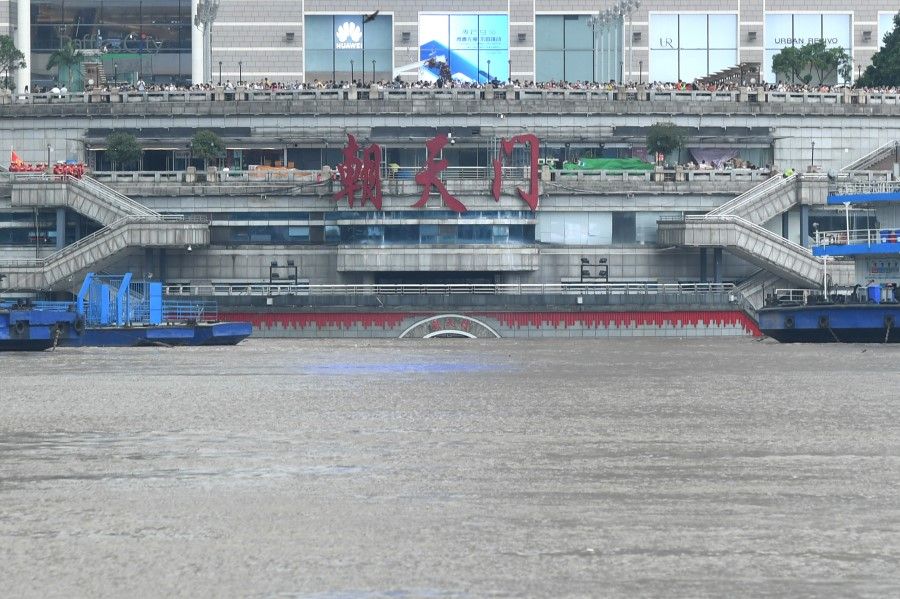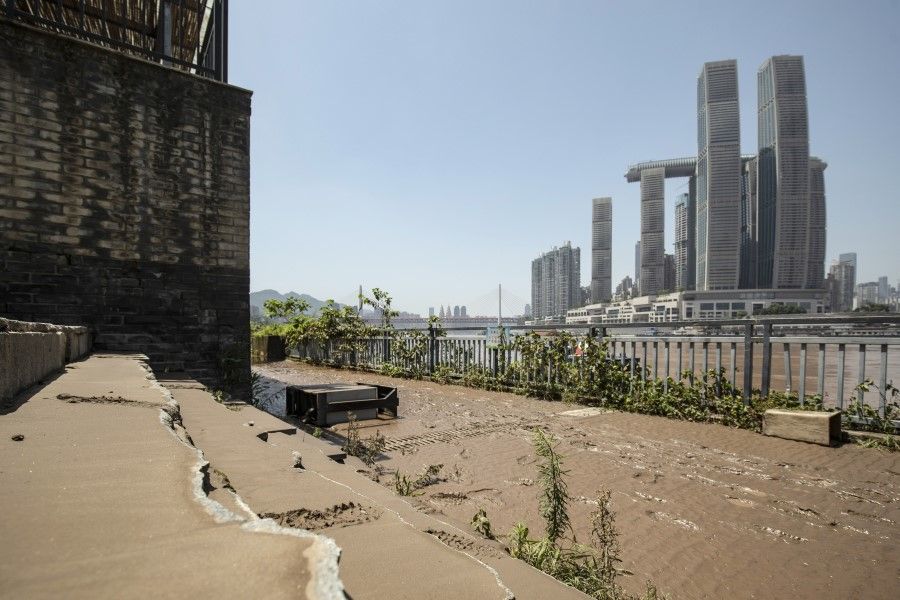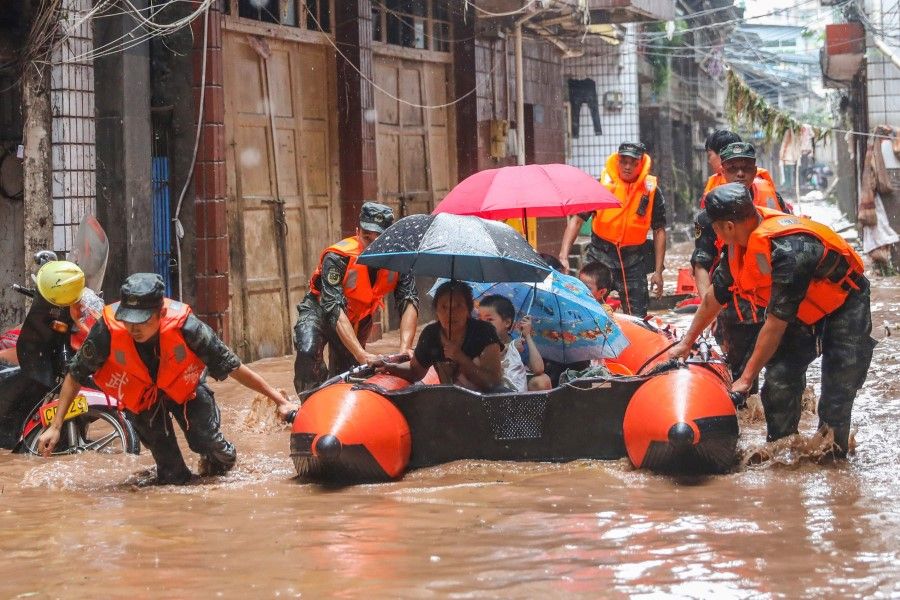Chongqing residents on worst floods in 40 years: This has not been a good year

Chongqing city's oven-like temperatures eased somewhat this week, dropping by over 10 degrees Celsius as cloud cover returned. But the cool respite came with light rain - an apparent warning to the teeming crowds in the city that they are about to see the worst floodwaters in 40 years.
Chongqing has been hit by several floods this year. In late July, the gate to the Chaotianmen area was half-submerged by floods, while just five days after the Yangtze River flooded for the fourth time, strong rains on the upper Yangtze led to the fifth flood. This led to the waters in the Chongqing sections of the Yangtze and Jialing rivers to go far beyond safety levels in the past couple of days, and the second worst flooding for Chongqing since July 1981, following the establishment of the People's Republic of China.
In the day or so before the floodwaters hit, its destructive power began to show. At Chongqing's landmark Chaotianmen Dock, at the confluence of the Yangtze and Jialing rivers, the waters rushed by, full of floating objects. By Tuesday afternoon, most of the steps on the riverbank were underwater, and the Chaotianmen Gate was completely submerged by that evening, with only "Chaotianmen" in red above the water. All boat activity at the dock was halted, with police lines everywhere to keep people away, and an impromptu crisis response command post set up in the main square.

Social media feeds were overrun by news of the toes of the Leshan Giant Buddha being submerged by this flood of the century. And news of the waters flooding the glittering Sheraton Chongqing Hotel on Nanbin Road, as well as the underground car park and commercial street in the popular Hongyadong sightseeing area, also got the internet community on the alert and holding their breath for the next flood.
The Chongqing authorities were prepared, activating on Tuesday the highest Level I emergency crisis response against the floods, the first-ever on record. According to interim statistics from China News Service, before the floods hit, over 15,000 people and over 60,000 tonnes of goods were shifted away from Yuzhong district.
After the usually bright Nanbin Road went dark for one night, the fifth flood from the Yangtze River and the second flood from the Jialing River both reached Chongqing city yesterday. The rushing, rising waters quickly submerged the roads along the river, including Nanbin Road, Changbin Road, and Jiabin Road, with traffic controls at many roads in the city.

"This flood is not that serious, it's not as high as in 1981." - Fu Shiyuan, Chongqing resident
My first stop yesterday was the Yuzhong Logistics Market on Changbin Road, which was flooded in late July. This time, the waters were fierce; the roads behind the market that were passable before were now underwater. Soldiers, police, and volunteers were setting up police lines in the Chuqimen area and advising the public not to go towards the flooded Changbin Road.
Fu Shiyuan, 74, has lived in Chuqimen for 40 to 50 years. Yesterday, paper fan in hand, he slowly walked uphill to a vantage point on Baixiang Street to survey the flooding, where many residents and office workers had also stopped to look.
Fu told me that people in Chongqing have a habit of "flood-watching", and he himself finds a vantage point every July and August to look at the floodwaters. As for the flooded Changbin Road below, he said evenly that the flood of 1981 came four steps away from Baixiang Street. "This flood is not that serious, it's not as high as in 1981."

But the younger generation is not as steady as Fu. Li Zhouzhou, 35, a ten-year resident of Changbin Road, was also in Chuqimen yesterday, daughter in tow, to look at the floodwaters. She said it was a shock, as she had never seen the waters flood Changbin Road, right in front of residential buildings.
"The waters were so strong, Nanbin Road is submerged. That has never happened before." - Mr Tu, Chongqing resident
The Yuzhong peninsula, Chongqing's city centre surrounded by two rivers, saw severe traffic blockages yesterday morning, while Chaotianmen was also congested. But this did not stop Chongqing residents from flocking to Chaotianmen Square to watch the floods and witness history.
Chaotianmen Square at noon was crowded. To my memory, the last time I saw so many people there was last September, when Raffles City Chongqing opened. Thousands of unworried, relaxed-looking Chongqing residents came to take photos - professionals with their SLR cameras, and hobbyists with mobile phones - while exclaiming that the dock had become "a watery expanse".
Mr Tu, 50, who lives in the Jiulongbo area west of the city, told me that he specially made the lengthy trip there. This is the first time he has seen such a major flood in Chongqing. "The waters were so strong, Nanbin Road is submerged. That has never happened before," he said. However, he was optimistic that the floods will not have too much impact.
(A Singaporean friend) took the stairs down in the dark at about 10am... when he got to the first storey, the water was already past his waist. Rescue personnel got him into a big waterproof laundry basket and dragged it to a nearby staircase where he could get to higher ground.
All the same, because the latest floods affected places with a higher concentration of property, the overall loss is likely to be higher than in late July. The Somerset Yangtze River Chongqing service apartments in lower Baixiang Street began flooding two nights ago, with the first storey covered by muddy yellow water.

A Singaporean friend who is a longtime resident of the building yesterday described his memorable evacuation experience. He said water and electricity supply at the building was disrupted at about 11pm two nights ago. He took the stairs down in the dark at about 10am yesterday morning, and when he got to the first storey, the water was already past his waist. Rescue personnel got him into a big waterproof laundry basket and dragged it to a nearby staircase where he could get to higher ground. This friend said the apartment only started operating four years ago, and was seriously damaged by the flood, with the concierge submerged, and no idea when operations will resume.
The floodwaters in Chongqing are still rising. The water level at Cuntan Station on the upper Yangtze - which has a direct impact on the safety of the city - yesterday breached the safety level of 6.94 metres, only 0.97 metres lower than the record in July 1981, with the water level expected to peak in the early hours of today. The Three Gorges Dam is also expected to see a record flow of 76,000 cubic metres of water per second into the dam.
The frequent floods have probably added to a sense of fatigue among the people of Chongqing. Li's comment probably reflects the general sentiment: "This has not been a good year. There have been too many disasters. Hopefully the floods won't come again."
